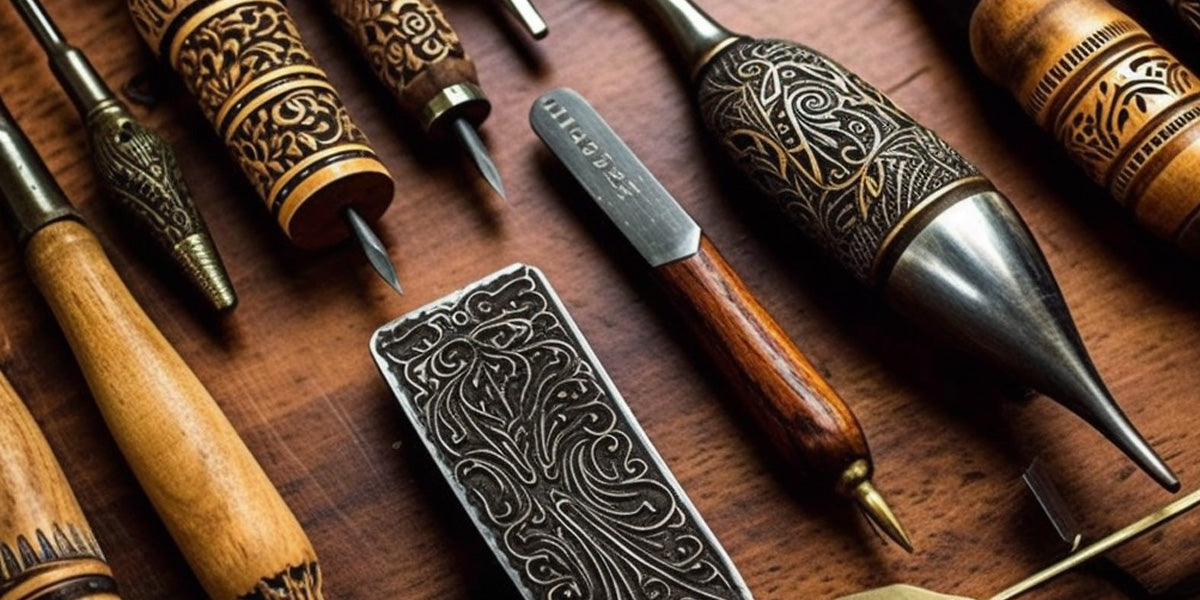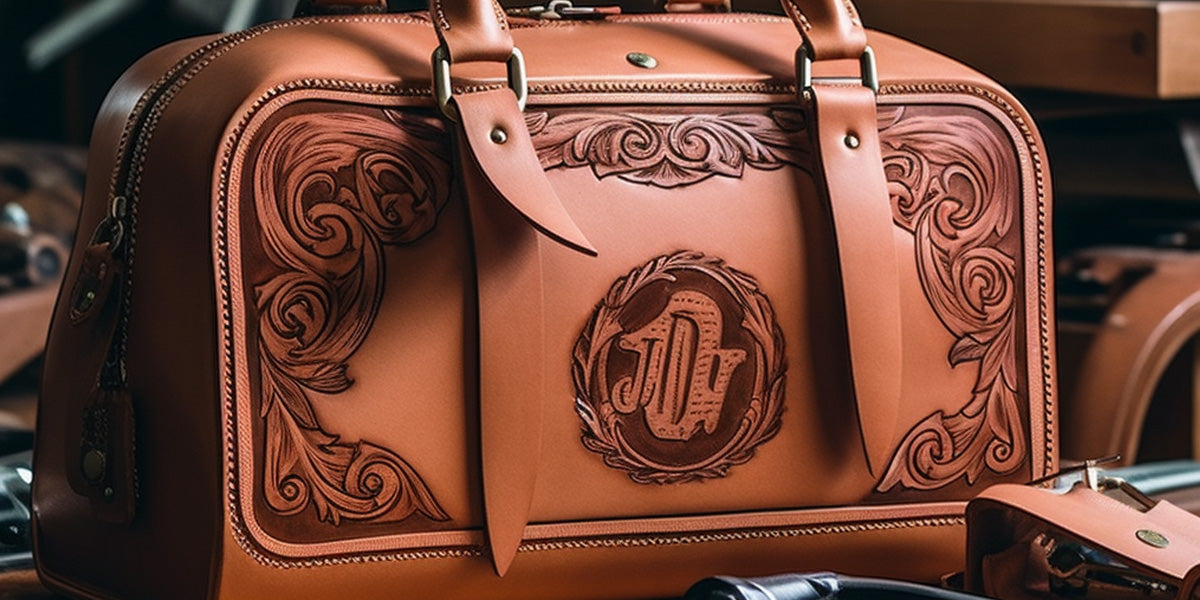
For generations, leather has been a preferred material for making various goods since it is durable and timeless.
It can be easily manipulated and engraved with various designs and features because of its inherent toughness and forgivingness.
The craft of leather engraving has been practiced and passed down from generation to generation.
Nothing is more exquisite than the simple and complex patterns that may be etched into the surface of leather.
They could be a traditional monogram letter or an elaborate design.
Whether you’re buying a leather item for yourself or as a present, making it distinctively yours and personalized makes it even more memorable.
Due to this, some businesses provide customers the option of adding some level of personalization.
Looking for a personalized leather item? Von Baer offer personalization on wallets, laptop bags, briefcases, backpacks, and travel bags.
What Exactly Is Leather Engraving?

You can personalize a leather-based object or give it a decorative appearance through leather engraving. Designs are permanently etched into the leather’s surface during the process.
With specialized tools, this etching is accomplished by cutting or stamping the design into the leather’s surface. This method of application produces a stunning and long-lasting finish.
You can do the leather engraving in various ways, including hand, laser, and even with a Dremel tool. The leather will appear differently depending on the technique used to engrave the material.
Leather Engraving Tools

The most popular instrument for hand engraving leather is a burin, a graver made of hardened steel. The burin manually carves the design into the leather’s surface.
Most people who make their own leather engraving utilize this instrument. The procedure takes a little longer, but the end result is just as satisfying.
Hand-engraving leather requires practice, just like everything else. Therefore, patience and time are your most valuable resources.
A leather punch or chisel and a leather mallet are used to create any holes that may be necessary for the leather component. It is a hand-held tool that makes a hole or a leather punch that works on the same principles as a paper punch.
Alternatively, the material can be pounded firmly with a leather mallet while a specialized chisel tool is pressed against it.
You can use numerous instruments available on the market for decorative designs. To get the required impression depth, press each on the leather piece and tamp it repeatedly with the leather mallet.
One thing to remember is that the impression depth will be more significant if you wet the leather before stamping it because a wet surface is more adaptable.
Leather Engraving Techniques
1. Branding

One of the simplest methods for leather engraving is undoubtedly branding.
Branding entails rubbing a hot metal object against the hide’s surface to burn a design into leather. This is similar to how a farmer brands his livestock.
This burnt area takes on a darker hue and a slightly sunken look where the brand was used. This makes it clearly stand out.
This, combined with a significant amount of force used for leather branding, results in this.
The branding iron is essential if you want to brand leather, so make sure you have it before you begin.
Many physical and online retailers sell various irons with pre-existing designs. However, some are open to developing new brands.
Additionally, you’ll need a reliable and secure method for holding the brand once you’re done. If your brand does not have a metal handle connected, you will need metal tongs or another tool that can withstand heat to grip it.
You can heat branding irons in a number of ways, including using an open flame or electric power. Anyone seeking to brand leather should take safety precautions in case of a fire, just like anything that involves burning a design.
Every time you brand something, be sure to do so in an area free of obstructions and to put on the appropriate safety gear (gloves, goggles).
2. Laser Engraving
Engraving with a laser is pretty much what it sounds like. With this engraving process, a powerful carbon dioxide laser is focused on a piece of leather, delicately burning a design into the material with concentrated light.
*This is the preferred method for Von Baer when personalizing bags with more complicated lettering or imagery. Learn more on our Personalization page.
Like branding, laser engraving burns the leather’s surface to create a pattern.
Due to the small size of a laser beam and the enhanced control an engraver has over the laser, laser engraving is typically a more exact procedure than branding.
This technique requires specialist equipment, but those who want to start with laser engraving may be able to do so without an overly elaborate or vast setup.
The engraver must exercise caution when using a laser to prevent a fire. In addition to branding, the high temperatures might pose a severe fire risk if sufficient safety measures aren’t performed.
Always wear the appropriate safety gear, including eye protection, when utilizing lasers. Vegetable tannins used in leather tanning might cause some discoloration as well.
As a trade-off, lasers can create distinctive and lovely patterns that conventional engraving methods simply cannot.
3. Embossing
When you emboss something, you imprint a pattern with a thick steel plate or rolling wheel.
Since the embossing technique merely touches the surface rather than removing or burning material, embossed leather can have various designs pressed into it while retaining a significant amount of the original leather’s grain.

Blind printing and color printing are the two primary types of embossing.
Blind Printing
Blind printing produces a pattern the same color as leather by simply pressing steel plates into the material without altering it.
Color Printing
A thin film layer typically sits between the leather and the plate for color printing. This allows the weight of the container to cut away sections of the film and imprint them into the fabric.
Embossing Leather
You can easily embellish leather with recurring patterns using embossing. The ease with which you emboss vast quantities of leather at once makes it one of the more popular ways in factories to produce leather furniture or similar things, even if it lacks the same level of precision as other engraving techniques.
While there is some chance that designs can deteriorate over time, you can avoid this mainly by coating the leather with oil after the embossing process and re-oiling throughout the years.
While embossing leather on an industrial size, such as in a factory, would pose some challenges, doing so on a smaller scale with smaller plates is very reasonable.
Many pre-made embossing plates are available online. However, individuals who are more dedicated to their work could create their own plates. You shouldn’t have trouble embossing from home if you have robust plates and enough pressure to press them into a piece of leather.
Learn more about Leather embossing.
4. Pyrography

Anyone attempting leather pyrography should be aware of fire risks, similar to branding. Albeit, the trouble is significantly lower given the considerably smaller size of the tools being used.
Since electric heating is more prevalent than open flames, it is much friendlier to newbies than most types of leather engraving.
5. Perforation

The most common application of leather perforation is for practical objectives, but it may also be deliberately used to produce extraordinary designs. This method includes puncturing a piece of leather with tiny holes to increase its permeability.
Beyond that, these holes can be strategically placed to create various patterns or images, especially when compared to unperforated leather components.
Due to the enormous amount of time and accuracy needed to execute it by hand, perforation is rarely performed by small-time hobbyists or artists. Instead, it is often exclusively used to build furniture and other items of the kind.
Because no one has the time to sit and carefully puncture each hole, perforation is a chore better left to machines.
Although most leather can tolerate perforation, it is not frequently used in clothes or accessories, given the subtlety of the resulting designs.
6. Carving

Leather can also be carved with various patterns, just like wood. However, unlike wood, only one type of leather – full-grain vegetable-tanned leather – will be suitable for carving.
This is because other varieties of leather don’t sufficiently saturate or retain the carved shapes after drying.
First, wet down a piece of leather with water and let it soak for a few minutes before carving.
Subsequently, carving an image into the material is a straightforward process that involves transferring the design with a tool similar to a stylus before cutting the lines with a ceramic swivel knife.
Then, you’ll cut out the fabric using chisels, scrapers, stamps, and other tools until the design has been wholly molded into the leather.
As was previously indicated, carving designs can only be done on a specific type of leather. Anyone seeking DIY will need to practice until they reach a pro level because properly chipping at a piece of leather also takes a lot of labor (i.e., try a basic design first and work up to something more extravagant).
These variables also make it difficult for technology to duplicate carved leather fully. Hence the majority of carved pieces are done by hand.
A sharp knife is essential for producing good results while carving leather. Throughout the carving process, sharpen your blade, often on a strop covered in jeweler’s rouge, to maintain precise lines and cuts.
7. Embroidery

Leather is perfect for a wide range of needlework projects, much like other fabrics. This is probably the most user-friendly leather engraving technique on the list because it requires few if any, specialist instruments.
A design or image is stitched into a piece of fabric with an embroidery needle. You can do this manually with a needle and thread or with a sewing machine. If sufficiently advanced or designed for the job, a sewing machine frequently includes a specialist embroidery program.
The softer forms of leather tanned with animal tannin or chromium salt work best for needlework.
Fortunately, as this is also the leather most frequently used to make apparel, you may quickly and without any concern sew a pattern into your favorite jacket. Make sure to use large and strong needles to puncture the material without bending if you decide to embroider on a tougher type of leather.
In addition to the apparent problem of a broken needle, bent tools create unequal holes in the material, giving the finished pattern a distorted and unappealing appearance.
It is advised that you clamp the portion of the fabric in place while stitching using an embroidery hoop to assist in stabilizing the leather as you work.
Contrary to popular belief, this shouldn’t permanently damage the surface unless the leather is of inferior quality. Any rings left behind are simple to remove with a soft brush or hand rubbing.
When embroidering, there really are just two things to watch out for, the first and most prominent of which are the needles. Keep an eye on where you’re stitching at all times, and keep your fingers away from the sewing machine’s needle.
Next, remember that whatever holes you cut in leather will last forever. Consider a design before you start, and try your best to stick to it.
To gain experience, therefore, it’s better to practice on an inexpensive item before starting to work on your favorite piece of clothing.
Related leather posts:
- Leather
- Faux leather
- Vegan leather
- Bonded vs faux vs real leather
- Bonded leather
- Genuine leather
- Pleather
- Top grain leather
- Leather types
- Leather guide for beginners
How to Use a Dremel to Engrave Leather
For optimal results, do the following when engraving leather with a Dremel tool:
- You must apply your preferred design or sketch to the leather’s surface. You can use heat transfer, a pencil, or an awl to make this transference.
- Next, you’ll fasten your Dremel tool with the thinner engraving point. It is preferable to begin with the narrower attachment until the first marks are visible in the leather.
- After placing the narrower lines, enlarge them by going back over them. The widening uses the same smaller attachment by periodically retracing the lines until you achieve the desired appearance.
Both finished and untreated leather responds nicely to this engraving process. Again, you can make the leather surface more manageable and suitable for engraving by moistening it first.
Related articles:
- What is leather patina
- Vegetable tanned leather
- Leather tanning
- What is artificial leather?
- What is full grain leather
- Where does leather come from
- Mushroom leather
- Napa leather
- Pebbled leather
- Leather grades
- How to burnish leather
- How to waterproof your leather bag
- How to clean leather bag
- How to restore faded leather bag
How to Engrave Leather Using a Cricut Machine
With a Cricut, you can cut leather, but you’ll need a few specialized tools. These instruments included a brayer, a deep point blade, and a hard grip mat.
- Then, you must construct your design in the design space on your Cricut.
- When dealing with leather, be sure to position the material’s flat side against the cutting mat. Roll the leather down using the bray to ensure that it is firmly fastened.
- Before starting to cut, ensure your photographs are set to mirror mode.
- Select leather in your material settings.
- Insert your deep-cut blade and move two of your rollers in each direction.
- Fill the cutting mat and hit the start button.
Is learning leather engraving easy?
Even though leather engraving is an art, anyone can learn it. There is a learning curve, like with most other kinds of artistic expression, but once you master the technique, the options are limitless.
Are leather-engraved items durable?
If properly maintained, the leather material can survive for many decades. And the engraving cut into the leather’s surface can also last for the same period.
Von Baer: Luxurious Italian Leather Products
For when only the highest quality leather will do, choose Von Baer.
Our products are defined by Italy’s finest full-grain leather, pure luxury.
Handmade by experienced craftsmen with decades of experience.
An investment in something beautiful that you'll treasure for years to come.
Conclusion
We hope you enjoyed our article on leather engraving.
If you have any questions or comments, contact us at info@vonbaer.com, or leave them in the comments.
Want to read more? Check out our related Leather pages here.






Leave a Comment
Your email address will not be published.